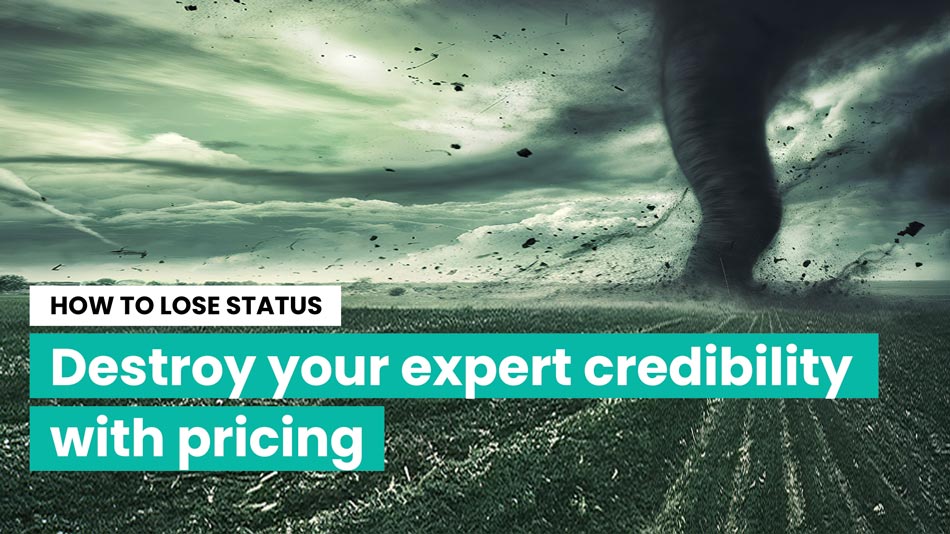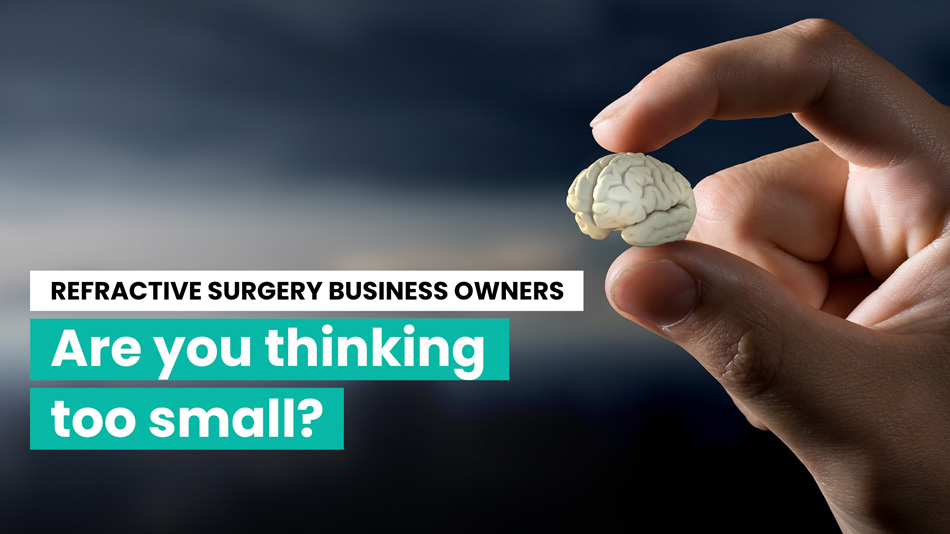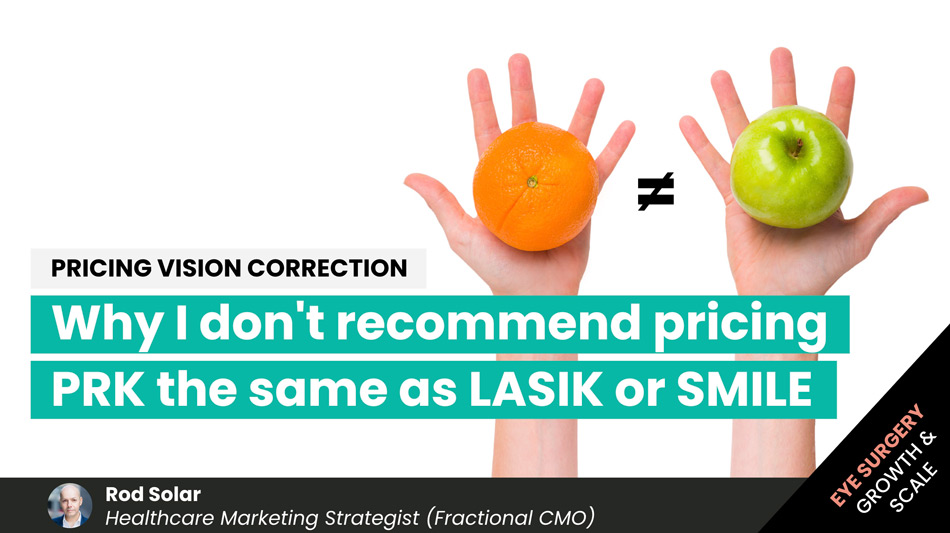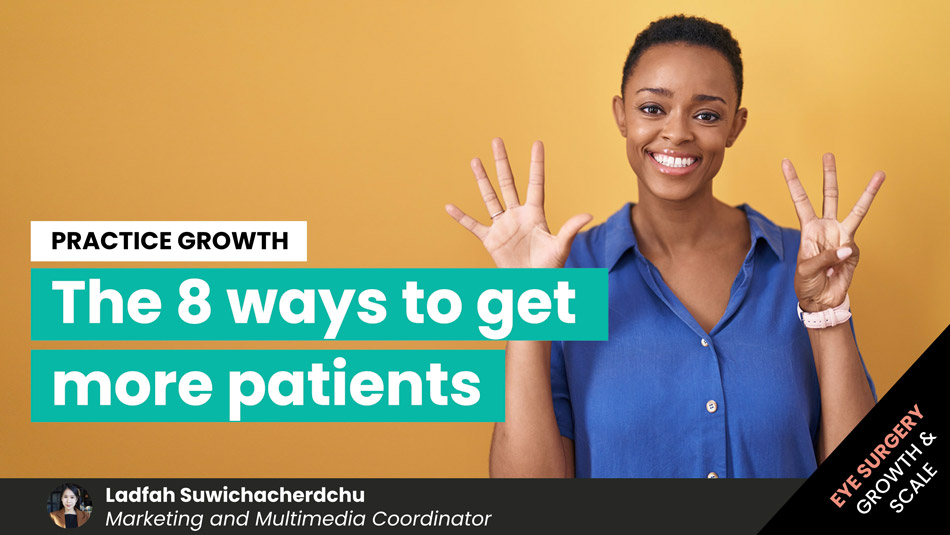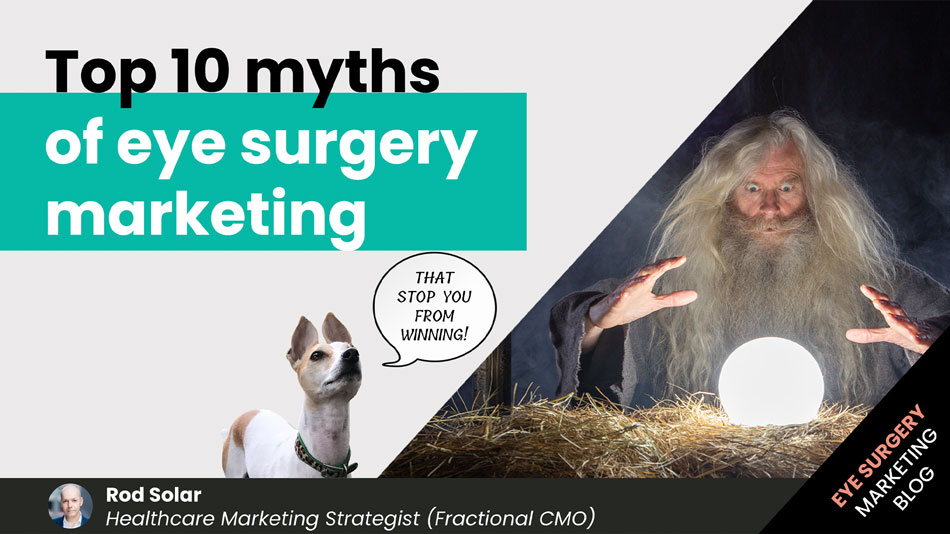
The Top 10 myths of eye surgery marketing
One of the things that become obvious as you spend more than a few decades on this globe are the many myths and misconceptions that get in people’s way.
I’m sure you’ve seen it in your patients. Knowledgeable and successful people in their fields often hold onto ideas that are simply not true.
We all know about the many myths and misconceptions surrounding laser eye surgery. But why should we be surprised that so many persist? After all, your patients aren’t laser eye surgeons.
Similarly, you are likely not a professional marketer. So, it’s only natural that you would have many myths and misconceptions about an unfamiliar subject.
So, we thought we’d reflect on the many myths and misconceptions we’ve observed in laser eye surgery marketing. Many of these may be stopping you from winning.
Myth 1: “Everyone who wears glasses or contacts wants to have vision correction surgery”
Many eye surgeons think this is true. Ergo, they resist taking marketing or sales seriously.
If this myth were true, everyone wearing glasses and contact lenses would call you and book appointments – and you’d be a LOT busier.
Fact: Only people who have problems with glasses and contact lenses want the outcomes of laser eye surgery enough to overcome their fears and pay for it.
Historically, that’s not a large percentage.
According to MarketScope, the case volume in 2015 was 1.5 cases per 1000 population (in wealthy nations).
Tiny but true. And, we’re not being pessimists.
We’re telling you this because we want you to appreciate that marketing and sales are NECESSARY. It’s not crass. It isn’t unclassy.
Marketing and sales are essential for your success.
Myth 2: “People want to buy eye surgery”
Fact: We don’t want your service, we want to become the person that we think your service will turn us into.
People want to move away from their challenging before-state and towards their more pleasant after-state. The bigger the transformation from their before-state to their after-state, the more they’ll happily pay.
Good marketing is simply the articulation from before to after. So, instead of offering eye surgery, offer an opportunity to see if they can have the after they seek.
Myth 3: “The more marketing ideas, the better”
Fact: “More companies die of indigestion than starvation.”
That quote, oft-repeated, is attributed to one of the godfathers of silicon valley startup culture- Bill Hewlett, co-founder of Hewlett Packard.
What he meant was that ideas are worthless without the focus and execution you need to implement them.
Most marketers (and may vision correction surgeons) see themselves as visionaries. Visionaries can be helpful for business growth, but the dark side of being a visionary is what Ryan Deiss of DigitalMarketer calls “Shiny Object Syndrome” – or, SOS.
The very first refractive surgeon I worked with over 20 years ago gave me this excellent piece of advice when I too was caught up in SOS – Finis coronat opus – which loosely translates to the end crowns the work.
Every 90 days, we ask our clients to choose 3 big ideas that we can implement within the next 90 days that will get the results we want. That’s how we get predictable growth, every 90 days.
Myth 4: “(Google /Facebook/ Instagram/ YouTube) advertising doesn’t work”
Fact: Success and failure exist on every platform – advertising is more than the 1) channel, it’s also 2) the message, 3) the offer and 4) repetition.
First, know your customer avatar. If they spend time on Google, advertise on Google. If they spend time on Facebook, advertise on Facebook… and so on. This also goes for radio, newspapers and other more traditional broadcast channels.
If you want to buy bananas, go to the supermarket. Similarly, when you want to buy traffic, go where your desired avatar spends time and buy traffic there.
Typically, it’s not the channel, it’s what you do on the channel that results in success or failure.
Second, clarify your message. Is it about you? They don’t care. Is it about them? Now you might get their attention.
Third, make the right offer. Don’t offer eye surgery. Instead, craft offers that deliver value in advance for free and small investments of time or money.
Fourth, repeat the ad far longer than you think you should.
Finally, test it against variants over time and adopt the ads that work best.
Myth 5: “You are the hero of the story”
Fact: Your customer is the hero. You are the guide.
Think of Star Wars. Obi-Wan Kenobi was a far more knowledgeable and experienced Jedi than Luke Skywalker ever hoped to become.
Yet, Luke was the hero of Episode IV, Kenobi was the guide.
Donald Miller, the author of Storybrand, counsels his students to apply what works in the most memorable and persistent stories we love to marketing.
He counsels to position your patient as the hero and you as the guide in your ads, website, emails, calls and appointments, .
Make it about them, their journey, their transformation from before to after.
You are there for them to trust to lead the way, step-by-step, with a thought-out plan that will lead the hero to where he wants to go – SUCCESS!
(NOTE: Want to see how your practice marketing measures up against the best in class? Take this 5-minute quiz to see how you stack up in the 9 areas of practice marketing and get specific tips and advice on how you can improve your weak points and better leverage your strengths).
Myth 6: “Low prices result in high volume, high prices result in less volume”
Fact: We don’t care as much about price as you might think we do.
In survey after survey, patients place price among one of the last criterion they used to choose their surgeon.
But, why does every prospective patient ask about price at their first opportunity? Because they don’t know what else to ask.
They don’t know how to compare lasers, procedures, surgeons, or facilities. But they do know how to compare prices.
So they start there.
Your job, therefore, is to give them the answer they seek and swiftly and deftly pivot the conversation to what they care about: VALUE.
So, do low prices or high prices result in more volume?
The answer is neither always does, when done in isolation. However, what results in more volume is more perceived value, driven by a documented patient journey, actionable metrics and well-chosen tools and tactics.
Myth 7: “People will choose the best surgeon (or procedure)”
Fact: We don’t make optimal choices. We satisfice.
When we’re marketing, we tend to assume that prospects will consume our messages, consider all of the available options, and choose the best one.
In reality, we don’t choose the best option. We choose the first reasonable option, a strategy known as satisficing1 Economist Herbert Simon coined the term (a cross between satisfying and sufficing) in Models of Man: Social and Rational (Wiley, 1957), quoted in Steve, Krug. Don’t Make Me Think, Revisited (Voices That Matter) (p. 24). Pearson Education. Kindle Edition..
If you study how people make decisions, you’ll observe that most people don’t act rationally, even when the stakes are high and the pressure is extreme.
Why?
- We’re usually in a hurry
- There’s not much penalty for guessing wrong
- Weighing options may not improve our chances
- Guessing is easier
That is not to say that people never weigh options before they choose. They weigh up easy things, like how high you came up on Google when they searched, how easy it was to find what they wanted on your website, and how the nice and confident call handler made them feel when they first called.
Myth 8: “I should spend less on marketing as time goes on”
Fact: They who spend the most will win the most customers.
In 2009, Jeff Bezos famously said: “Advertising is the price you pay for having an unremarkable product or service.” It’s no secret that Bezos doesn’t (or rather, didn’t) believe in ads. He’s since changed his mind2 https://www.inc.com/tommy-mello/jeff-bezos-used-to-mock-this-marketing-strategy-but-hes-now-pouring-big-bucks-into-it.html#:~:text=In%202009%2C%20Jeff%20Bezos%20famously%20said%3A%20%22Advertising%20is%20the%20price%20you%20pay%20for%20having%20an%20unremarkable%20product%20or%20service.%22%20It%27s%20no%20secret%20that%20Bezos%20doesn%27t%20(or%20rather%2C%20didn%27t)%20believe%20in%20ads%2C%20but%20he%27s%20since%20changed%20his%20mind..
Today, he’s one of the biggest ad spenders on the planet because he now understands that to acquire more customers, you need to spend more on marketing.
When it comes to customer acquisition, one of the most common rules of thumb is to have a 3 to 1 LTV (Lifetime Customer Value) to CAC (Customer Acquisition Cost) ratio.
So, as long as you’re acquiring a customer for about a third of what that customer is worth to you, then you’re near the right place.
Instead of trying to get more ROI on your marketing budget to grow,
- focus your activity on your best payback campaigns.
- Increase your average customer value (e.g. your price)
- Allocate a higher percentage of your gross margin
- Secure growth capital to fund your campaigns.
Don’t focus on spending less (e.g. cost per click, reducing the budget, cutting costs), instead focus on getting more customers and EARNING MORE.
Myth 9: “I must consider my colleagues’ opinions when I market my practice”
Fact: Unless your colleagues pay your practice’s bills, focus on what drives results
If your peers are not in private practice, then they will have different views on what success is and it requires. For them, patients arrive in their operating theatres with seemingly little effort. All they need to do perform well on the day and keep their reputations clean.
Thus, they judge you, the private practitioner, by those same standards. Therefore, they might see marketing as unnecessary, manipulative, or even unethical. That is especially true in more traditional environments where the private practitioners are in the tiny minority.
The reality is that they don’t have the same needs, aspirations and obligations you do, which is to grow your private practice from scratch.
If your critical peers are in private practice, then you need to think about why they might disapprove of you. Might your success potentially eclipse theirs? Might they see the pie as finite, with you taking a larger piece than theirs at their expense?
The truth is, your competition may like you personally, but they don’t want you to win at their expense.
Even this scarcity mentality, however, is a logical fallacy – a zero-sum game. As I pointed out in Myth 1, the opportunity is virtually INFINITE while the current volume is relatively low.
The one caveat to this approach is that you needn’t overtly compare yourself to your competition to win. When surgeons work together to build each other up, the WHOLE MARKET grows.
Myth 10: “I need to have everything in place (and purchased) before I start marketing”
Fact: Your business is your patients, not your facilities, staff, or technology.
Don’t confuse the business with your overhead. Your business is the value it can generate. The value is in your patients.
Therefore, don’t wait to have all of your ducks in a row before you start thinking about marketing.
You should ask, before anything else, is there a market for what I’m offering?
- Can you identify the market?
- Can you reach the market?
- Can you monetise the market?
Only when you can answer “YES” to these three questions should you even BEGIN to start shopping for a facility, or laser or start hiring staff.
After you’ve answered those questions, your next tasks are to answer:
- How (precisely) will you create customers from scratch?
- How will you evaluate success?
- How will you then choose and implement the tools and tactics you need to make it all happen?
Put first things first. Marketing should be what helps answer the fundamental Go or No-go question:
“Should or shouldn’t I do this?”
And that’s not all…
As we brainstormed a list for this post, we identified many more myths and misconceptions we’ve all heard over the years. These myths are equally pervasive but more focused on specific tactics.
So, we’ll explore them in future blog posts. In the meantime, if you’d like to see examples of your peers that broke through these established misconceptions, we’d be happy to talk about it.
(NOTE: Want to see how your practice marketing measures up against the best in class? Take this 5-minute quiz to see how you stack up in the 9 areas of practice marketing and get specific tips and advice on how you can improve your weak points and better leverage your strengths).
About the author
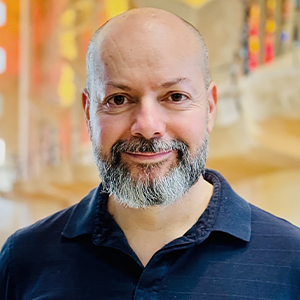
Rod Solar
Founder & Scalable Business Advisor / fCMO
Rod Solar is a co-founder of LiveseySolar and a Scalable Business Advisor for its customers. Rod mentors and coaches eye surgery business CEOs/Founders and their leadership teams to triple their sales, double their profit, and achieve their “ideal exit”.
Related Posts
Meet our Co-Founders
We’re passionate about helping leaders of high-quality, growth-minded practice owners double their practice revenue

Rod Solar
Founder & Scalable Business Advisor
For over 20 years, I’ve helped ophthalmology entrepreneurs scale their private practices. I specialise in doubling revenue within three years by offering a proven framework, hands-on experience, and a team of experts who implement what works. We take the guesswork out of growth and scale, so you can focus on delivering exceptional patient care while maximising the value of your business.
LiveseySolar completely transformed the way we were approaching this… We’ve gone from having just the dream of having a practice to having a practice up and running with people making inquiries and booking for procedures… It’s extremely pleasing. We feel lucky we connected with LiveseySolar.
— Dr Matthew Russell, MBChB, FRANZCO, specialist ophthalmic surgeon and founder of VSON and OKKO

Laura Livesey
Founder & CEO
I’m the co-founder & CEO of LiveseySolar. I’ve developed powerful eye surgery marketing systems that increase patient volumes and profits for doctors, clinics, and hospitals, since 1997.
Rod and Laura know as much about marketing surgery to patients as I know about performing it. They are an expert in the field of laser eye surgery marketing. They know this industry inside out. I believe that they could help many companies in a variety of areas including marketing materials, sales training and marketing support for doctors.
— Prof. Dan Reinstein, MD MA FRSC DABO, founder of the London Vision Clinic, UK






